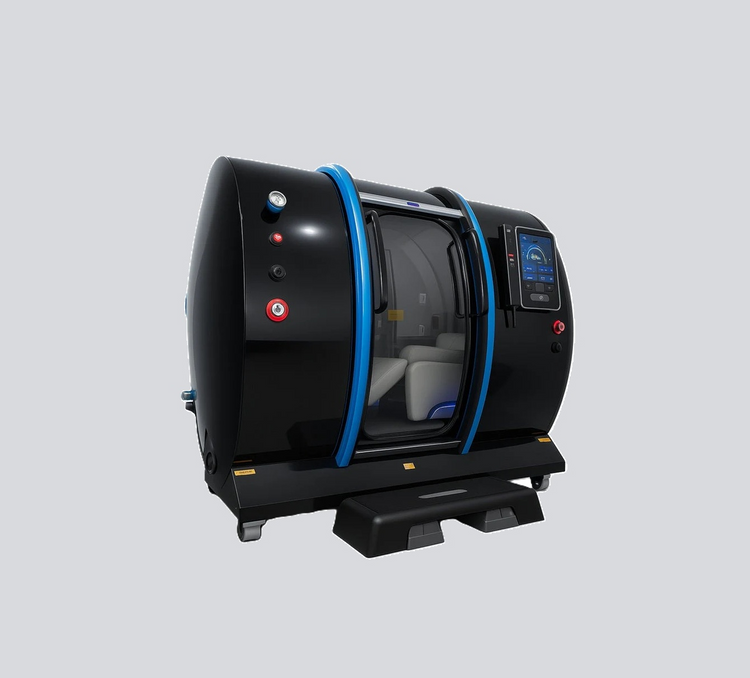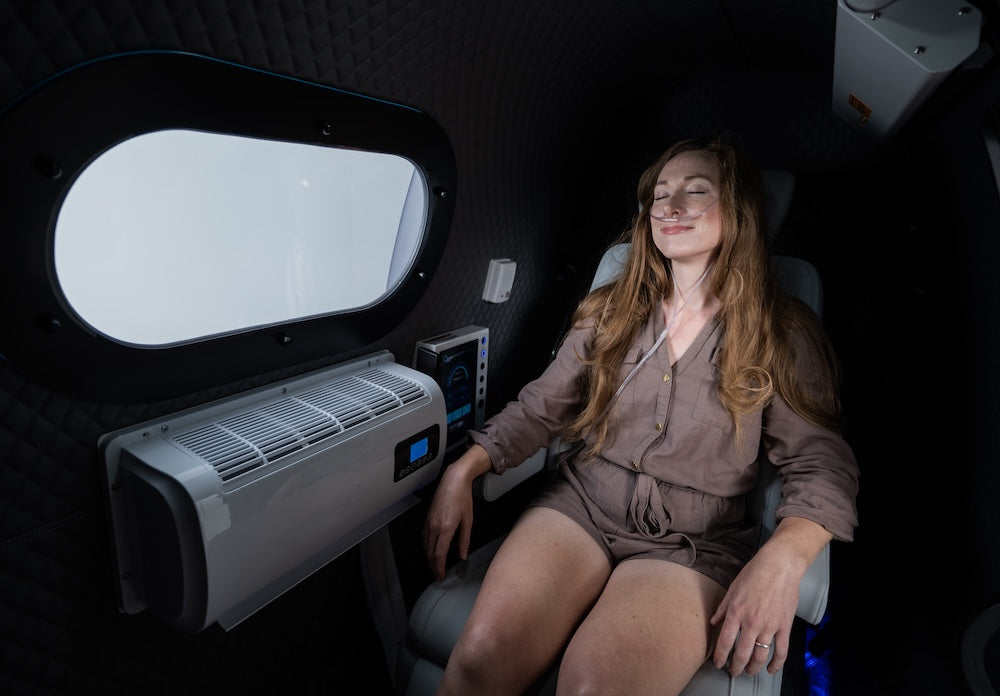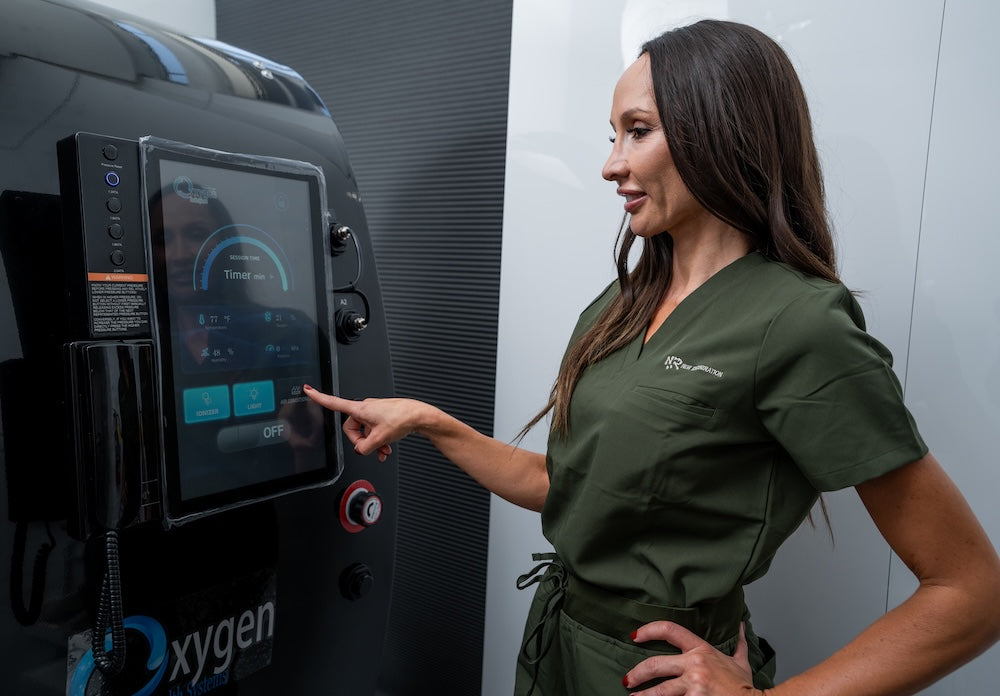Collection: Hyperbaric Oxygen Therapy (HBOT)
Experience the healing power of Hyperbaric Oxygen Therapy (HBOT). By breathing 100% medical-grade oxygen in a pressurized chamber, HBOT delivers oxygen deep into tissues with limited blood flow, promoting recovery, reducing inflammation, supporting cognitive function, and enhancing post-injury or post-cosmetic healing. FDA-approved and clinically supported, this therapy boosts overall wellness and helps your body perform at its best.

What is Hyperbaric Oxygen Therapy?
Hyperbaric Oxygen Therapy (HBOT) is a prescribed treatment that is approved by the FDA and AMA. With this therapy, a person breathes 100% medical-grade oxygen in a pressurized chamber. Oxygen under pressure is well documented and supported by scientific research and clinical trials.
During hyperbaric oxygen therapy, high levels of oxygen dissolve into the blood, plasma, and tissues. This process allows oxygen to reach areas where there is little blood flow due to inflammation, injury, infection, or disease. Hyperbaric Oxygen Chamber Therapy has incredible healing properties that The growth of new blood vessels enhances blood flow, tissue growth, Post-cosmetic recovery, muscle restoration, cognitive functions, . This treatment is also known to help numerous medical conditions and improve the overall quality of life for many people.
Real industry-approved high-pressure Hyperbaric Oxygen chambers use pressures of 2.0 to 3.0 ATA, while low-pressure therapy may be conducted at 1.5 to 2.0 ATA. When lower pressure chambers are used such as the inflatable HBOT’s, treatment time may be long and not very effective.

The Science Behind Hyperbaric Oxygen Therapy
Knowing the science behind hyperbaric is interesting. Hyperbaric Oxygen Therapy involves breathing in 100% pure oxygen while sitting or lying down in a pressurized chamber. The whole process is often pain-free and non-invasive. While inside a chamber, you will be breathing 10 to 20 times more oxygen than you would regularly breathe through the concentrated 21% oxygen you get from the current air outside. Oxygen Saturation Fights Infection – When the fluids and tissues within the body are saturated in oxygen, the body is no longer an ideal environment for anaerobic bacteria to thrive and cause infection. HBOT directly kills anaerobes, enhances the ability of white blood cells to engulf and digest bacteria and fungi, and enhances the ability of amino glycoside antibiotics to function.
Increased Oxygen Levels – Through HBOT induced vasoconstriction and hyperoxygenation, the treatment simultaneously reduces edema and increases oxygenation. A patient’s tissues are hyper oxygenated by increasing the plasma oxygen concentration 10 – 15 times which allows the oxygen to provide immediate support to areas with compromised blood flow. HBOT is being utilized to treat a variety of illnesses, the Food and Drug Administration (FDA) has authorized HBOT treatment for 14 illnesses and diseases. Nevertheless, many trials have shown that HBOT is successful in treating a variety of other illnesses, and it has been permitted for practice in more than 50 countries across the world.

The Benefits of HBOT:
- Assists with impaired circulation
- Improves brain cell function.
- Improves immune system response.
- Facilitates cellular detoxification.
- Assists in the growth of new blood vessels.
- Restores oxygen to depleted tissues and cells.
- Increases the production and release of stem cells by 800%.
- Increases plasma oxygen concentration 10 to 15 times.
- Enhances the body’s natural healing process.
- Provides oxygen to areas with compromised blood flow.
- Enhances white blood cells’ ability to destroy bacteria and fungi.
- Enhances the formation of collagen and new tissue growth.
- Reduces swelling, inflammation, bruising, infection, scarring, and the recovery time from surgery and injury.
- Studies suggest HBOT reawakens the dormant neurons that are alive but not functioning in and around the injured tissue of the brain.
- Patients undergoing open heart surgery have better brain function if they receive hyperbaric oxygen prior to surgery.

Conditions That Hyperbaric Oxygen Therapy Can Help?
- Main treatment with scientific evidence
- Gas Gangrene
- Decompression Sickness
- Radiation Tissue Damage
- Air or Gas Embolism
- Thermal Burns (severe)
- Failed Skin Grafts & Flaps
- Carbon Monoxide Poisoning
- Central Retinal Artery Occlusion
- Chronic Refractory Osteomyelitis
- Intracranial Abscess
- Arterial Insufficiency
- Necrotizing Soft Tissue Infections
- Diabetic Lower Extremity Wounds
- Crush Injury & Other Acute Traumatic Ischemias
- Sudden Sensorineural Hearing Loss
- Osteoradionecrosis
- Clostridial myonecrosis
- Compromised skin graft and flaps healing
- Improving the effects of the effects of aminoglycosides, vancomycin, and other antibiotics
- Severe Anemia (Acute anemia used as a bridge therapy)

Adjunctive treatment with scientific evidence :
- TBI
- Stroke
- Autism
- Cancer
- Diabetes
- Gas infection
- Sports Injuries
- Radiation-induced injury
- Refractory osteomyelitis
- Prolonged wound healing failure
- Acute marginal ischemia
- Improved curative in designated problem injuries
- Necrotizing soft tissue infections
The healing powers of HBOT can be thanked by a couple of benefits. These benefits include hyperoxygenation, anti-inflammation, Immune Boost, Neovascularization, Stem Cell Growth, and reverse-aging of telomeres.
The information contained on this website is for information and educational purposes only and should not serve as a replacement for medical advice from your physician. New generation Health Center recommends that you consult with a physician before pursuing ANY form of medical treatment, including Hyperbaric Therapy.
